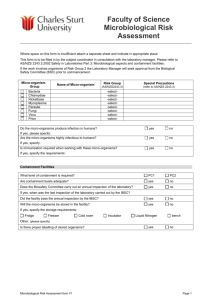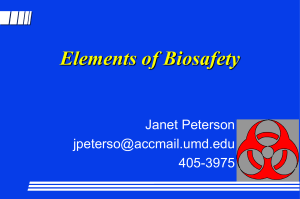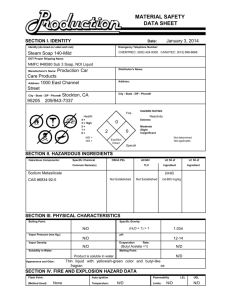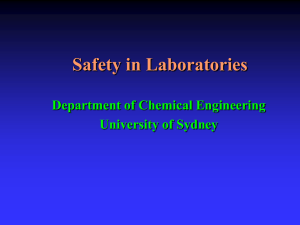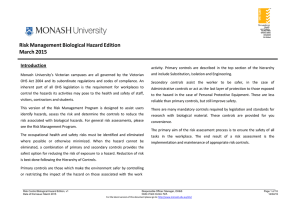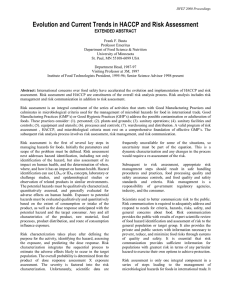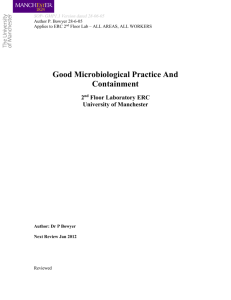Microbiological Risk Assessment Form This form is intended to
advertisement
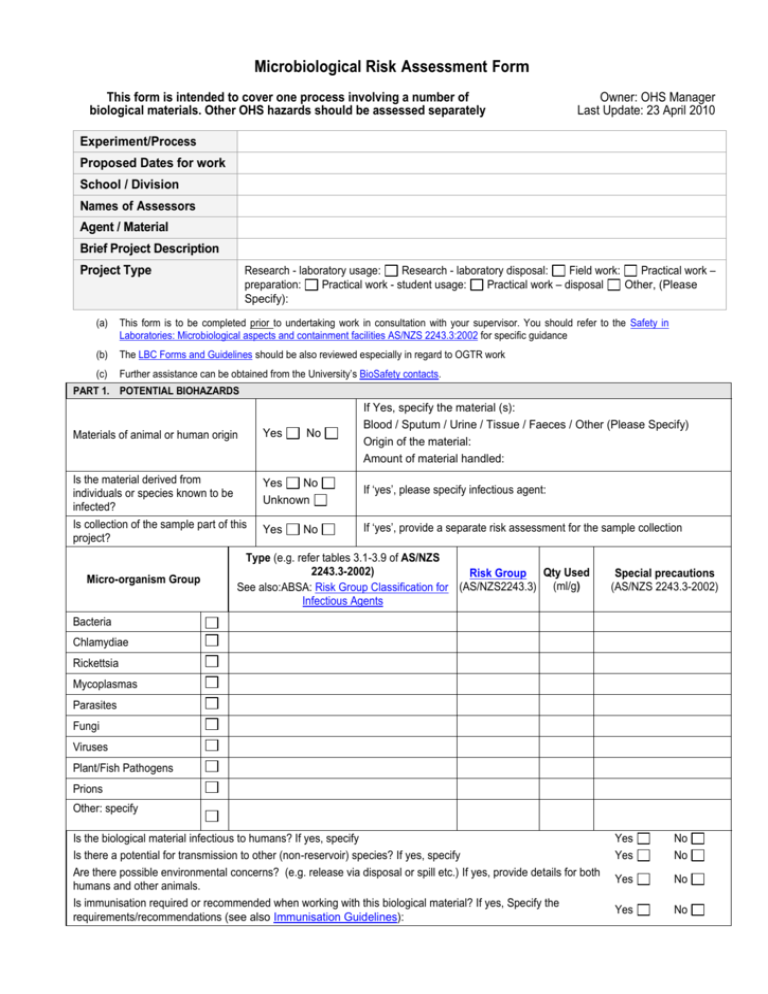
Microbiological Risk Assessment Form This form is intended to cover one process involving a number of biological materials. Other OHS hazards should be assessed separately Owner: OHS Manager Last Update: 23 April 2010 Experiment/Process Proposed Dates for work School / Division Names of Assessors Agent / Material Brief Project Description Project Type Research - laboratory usage: Research - laboratory disposal: Field work: Practical work – preparation: Practical work - student usage: Practical work – disposal Other, (Please Specify): (a) This form is to be completed prior to undertaking work in consultation with your supervisor. You should refer to the Safety in Laboratories: Microbiological aspects and containment facilities AS/NZS 2243.3:2002 for specific guidance (b) The LBC Forms and Guidelines should be also reviewed especially in regard to OGTR work (c) Further assistance can be obtained from the University’s BioSafety contacts. PART 1. POTENTIAL BIOHAZARDS Materials of animal or human origin Yes Is the material derived from individuals or species known to be infected? Is collection of the sample part of this project? Yes No Unknown If ‘yes’, please specify infectious agent: Yes If ‘yes’, provide a separate risk assessment for the sample collection Micro-organism Group No If Yes, specify the material (s): Blood / Sputum / Urine / Tissue / Faeces / Other (Please Specify) Origin of the material: Amount of material handled: No Type (e.g. refer tables 3.1-3.9 of AS/NZS 2243.3-2002) Risk Group Qty Used See also:ABSA: Risk Group Classification for (AS/NZS2243.3) (ml/g) Infectious Agents Special precautions (AS/NZS 2243.3-2002) Bacteria Chlamydiae Rickettsia Mycoplasmas Parasites Fungi Viruses Plant/Fish Pathogens Prions Other: specify Is the biological material infectious to humans? If yes, specify Is there a potential for transmission to other (non-reservoir) species? If yes, specify Are there possible environmental concerns? (e.g. release via disposal or spill etc.) If yes, provide details for both humans and other animals. Is immunisation required or recommended when working with this biological material? If yes, Specify the requirements/recommendations (see also Immunisation Guidelines): Yes Yes No No Yes No Yes No Microbiological Risk Assessment Form PART 2. PHYSICAL CONTAINMENT FACILITIES Where is the proposed work to be conducted? Campus Building No. Room No(s). Who is responsible for the maintenance of the laboratory facilities and equipment: name and contact number: What Physical Containment (PC) level is required? PC Level 1 PC Level 2 PC Level 3 PC Level 4 Has an inspection of the laboratory been conducted by the person wishing to use the biological Yes material? If not, conduct inspection and verify suitability. Is there adequate signage to indicate containment level and entry requirements? Yes If Genetic Manipulation work is carried out, are the procedures in accordance with the Gene Yes Technology Act 2000? If yes, what is the OGTR approval number? No. No No No N/A N/A Are imported or quarantine biological materials used? If Yes AQIS Permit No. Yes No Will the biological material be stored in the working environment? If yes, specify the Storage Requirements: Fridge Cold room Incubator Freezer Liquid Nitrogen Yes No Is there proper labelling of stored biological material? Yes No Is there a need to transport biological material from/to the laboratory or other areas? Yes No Other (Specify) PART 3. PROCEDURES AND RISK CONTROLS What procedures will be used with the biological material? Aspiration Sonication Vigorous Shaking/Mixing Pouring Blending Pipetting Grinding Using Automated Equipment Centrifugation Microbiological/Tissue Culture Other, Please Specify Are there written procedures in case of accidents and/or spillage? Is there appropriate equipment and supplies to cater for accidents and/or spills? Are there adequate washing facilities available for use? Are there appropriate sterilisation/autoclave facilities available? Are procedures for cleaning or laundering of protective clothing adequate? Have risk assessments been conducted for electrical machines? Is collection/treatment/disposal/ of infectious material appropriate? List specific procedures: Slide Preparation Freeze Drying Opening Freeze Dried Material Dissection Yes Yes Yes Yes Yes Yes Yes PART 4. PROPOSED PRECAUTIONS/CONTROLS AGAINST BIOHAZARDS List known medical effects or symptoms of unintended exposure to the material List the protective devices required, including Personal Protective Clothing/ Equipment. Biological Safety Cabinet (C1) Safety Glasses Safety Goggles Biological Safety Cabinet (C2) Sharps Disposal Face Shield Biological Safety Cabinet (C3) Respirator Face Mask Clothing Laboratory coat / coverall / apron (specify type) Appropriate Glove Type Appropriate Disinfectant Waste disposal method Other (specify) Have the following factors been adequately considered and implemented? General Safety Training Yes No N/A Standard Operating Procedures Yes Task Specific Training Yes No N/A Permit to Work Yes No No No No No No No N/A No No N/A N/A N/A Microbiological Risk Assessment Form PART 5. RISK REVIEW List the top five OHS hazards associated with the project and the corresponding control measures: Hazard Control Measures (Note whether in place or planned) 1 2 3 4 5 PART 6. COMMENTS AND APPROVAL INFORMATION Comments of the person carrying out the assessment: Name: Date: After reviewing the Risk Assessment and any supporting documentation, has the Laboratory and Biosafety Committee (or delegate) approved this project? Comments of the Laboratory and Biosafety Committee (or delegate) : Name: Date: Risk assessment must be reviewed again before? Yes LBC Registration No. No Microbiological Risk Assessment Form Microbiological Risk Groups (AS 2243.3) Risk Group 1 (low individual and community risk)—a microorganism that is unlikely to cause human, plant or animal disease. Risk Group 2 (moderate individual risk, limited community risk)—a pathogen that can cause human, plant or animal disease, but is unlikely to be a serious hazard to laboratory workers, the community, livestock, or the environment; laboratory exposures may cause infection, but effective treatment and preventive measures are available, and the risk of spread is limited. Risk Group 3 (high individual risk, limited community risk)—a pathogen that usually causes serious human or animal disease and may present a serious hazard to laboratory workers. It could present a risk if spread in the community or the environment, but there are usually effective preventive measures or treatment available. Risk Group 4 (high individual and community risk)—a pathogen that usually produces life-threatening human or animal disease, represents a serious hazard to laboratory workers and is readily transmissible from one individual to another. Effective treatment and preventive measures are not usually available. The categorisation is based on the infective hazard to healthy workers and does not allow for any additional risk for example caused by pre-existing disease, the effects of medication, compromised immunity, pregnancy or breastfeeding. Also the categorisation does not take account of any allergenic or toxic properties of the micro-organism or its products. Additional risks to such workers should be taken in to account in the risk assessment. The biological agents in the four hazard groups can be defined as follows: HAZARD GROUP PATHOGENICITY FOR HUMANS HAZARD TO WORKERS SPREAD TO COMMUNITY EFFECTIVE PROPHYLAXIS OR TREATMENT 1 Unlikely to cause human disease 2 Can cause human disease May be Unlikely Usually available 3 Can cause severe human disease May be serious May spread Usually available 4 Causes severe human disease Serious Likely Usually none
